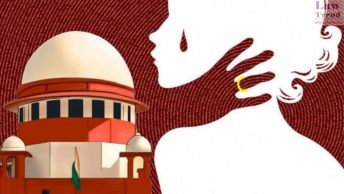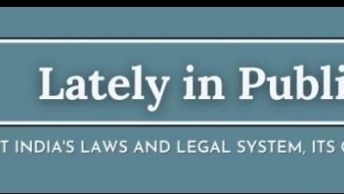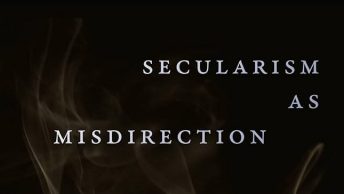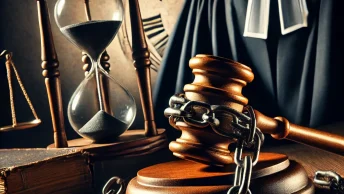An Injudicious Fraud
Guest post by B.N. Suchindran, an advocate of the Madras High Court.
“It is settled law that a constitutional authority cannot do indirectly what it is not permitted to do directly. If there is a constitutional provision inhibiting the constitutional authority from doing an act, such provision cannot be allowed to be defeated by adoption of any subterfuge.”
– Bhagwati J., in D.C. Wadhwa v. State of Bihar, (1987) 1 SCC 378.
Self restraint and recognition of the one’s own limitations are the need of the hour. In our constitutional scheme, the Supreme Court and High Courts are essentially courts that are meant to declare the law. Of late, too much of the “individual predelictions” of judges have been allowed to seep into the constitution. Hidden in the frequent praise for judicial activism, lies the spectre of an aristocracy of the robe. The judiciary is capable of subterfuge as much as any other organ of the state. Unfortunately, judges have become in Cardozo’s famous phrase, ‘knight errrants of the law.’
Certainty in the law is important for its development. It is the bedrock of true justice. As Seervai noted, “The greatest danger to the administration of justice and constitutional interpretation arises from the genuine desire of judges to do justice in each individual case.” The doctrine of precedent is itself an important check on the freedom of the judicial power.
And this uncertainty has been encouraged by the judicious ignoring of an important constitutional mandate. Article 145 (3) of the Constitution of India states that the minimum number of judges who are to sit for hearing any case involving a substantial question of law as to interpretation of this constitution or for the purpose of hearing any reference under Article 143 shall be five. The use of the word ‘shall’ is clearly indicative of the mandatory nature of the constitutional mandate.
In the early years, the Court interpreted this to mean that it is only the constitutional question in a case that has to be decided by the constitutional benches and any other questions could be decided by a smaller bench. As the workload of the court grew the practice of having smaller benches has become the norm under the ruse that the law once having been declared a smaller bench is merely applying it. However, in many cases, the observation of smaller benches have substantially altered the interpretation of the provision. In Union of India v. Raghubir Singh, (1989) 2 SCC 754, the Court had suggested that for the purpose of imparting certainty and authority to the judgement of the Supreme Court, it would be preferable if all judgements are rendered by Division Benches of at least three Judges unless it is not conveniently possible for compelling reasons.
A classic example is Bandhua Mukti Morcha v. Union of India, (1984) 3 SCC 161, where substantial changes to the law of standing and the interpretation of Article 32 were brought about by a 3 judge bench. In Mohini Jain v. State of Karnataka, (1992) 3 SCC 666, a two judge bench of the Supreme Court made substantial changes to the interpretation of the Article 21 by including the right to education within its ambit. A more recent example is Selvi v. State of Karnataka, (2010) 7 SCC 263 where are a 3 judge bench of the court considered the question of whether narco-analysis is violative of the right against self incrimination embodied in Article 20(3) of the Constitution.
I would submit that these judgements are passed without jurisdiction. Hence, they would effect, be a nullity, since the benches which decided them were not constituted in accordance with the mandates of law. This defect could only have been remedied if the judgement purports to follow a clear statement of a previous constitution bench in which the exact same substantial question of law was raised.
The reason for this rule is specifically that the decision of the elected representatives of the people should not be lightly set aside by the different predilections or opinions of individual judges. Judicial review is meant to act as a check on the majoritarian tendencies that can often sway democracies. It was the understanding, rightly, of the framers that a larger bench would promote greater objectivity and clarity in the statement of the law declared. Today, the increasing pusillanimity of puisne judges ensures that really speaking it is the senior judge who writes the judgement entirely.
The higher courts must declare the law with clarity and authority in order to ensure that their orders get the respect they deserve from the people and the courts below. In the long run, this will minimise the necessity for an appeal or ‘taking a chance’. It will have the salutary effect in the long run of reducing cases that are filed in the hope that they may find a sympathetic judge. Neither justice nor the development of the law is meant to be a game of dice!







a broader study could be made to look at how many times was a constitutional bench deciding cases which have involved expansion of the ambit of Art. 21, which in all fairness has been stretched to cover almost everything under the sun today and calls for a review of the same practice in my opinion at least
But from a consequalist standpoint, are smaller benches necessarily a bad thing given the priority attached to doing justice in particular cases over making good law especially nowadays amidst all the media pressure? Poorly analyzed opinions are not all that infrequent; As the previous comment mentions, art.21 is a case in point which has become an open box where pretty much anything is being thrown in. Selvi v. Karnataka as well – the analysis wrt 20(3) has several significant flaws and a failure to follow established precedent. So the damage done by smaller benches may be less than with CBs as they stand a better chance of reversal at a later date.
@thenumber10: I agree with you that an deeper empirical study should be made. Article 21 is not only a classical example of unnecessary interpretative expansionism, but has also resulted in dilution of the actual right protected since most of the "in rem" judgements passed under that article are not practically enforceable and have not been enforced.
@dilip Rao: A larger bench forces the judges to compromise and reach a point of common agreement. So the damage done by smaller benches will endure till it finally comes before a larger bench. It is better to have a constitutional bench give an authoritative pronouncement which will last for some time. Opinions amongst judges will always vary, but certainty should not be sacrificed at the altar of doing individual justice. In other words, "Justice should not vary with the Lord Chancellor's foot" especially in a court of final resort.
I don't think smaller benches can be realistically precluded from engaging in constitutional interpretation. When a matter is instituted in the Supreme Court, it is first heard by a division bench (two judges)and is usually referred to a larger bench only after the lawyers' have shown that it involves a 'subtantial question of law' or requires a resolution of conflicting precedents. In some cases, the judges themselves recognise the need to refer the case to a larger bench. Such a determination is always of an ex ante variety. At the time of referral to a larger bench (3 or 5) one cannot reasonably predict whether the judges will ultimately offer a novel interpretation of constitutional provisions. Whether or not a particular decision significantly changes the understanding and scope of constitutional provisions is an aspect that can only be examined in an ex post fashion. Furthermore, when a constitution bench has recognised a broad principle (e.g. protection of privacy or dignity) i really don't see why new cases seeking to expand the boundaries of those protections should be necessarily referred to 5 judge benches. One of the precepts of common law adjudication (as well as the Dworkinian formulation of 'law as integrity')is that judges search for the best possible answer while still trying to root it in precedent. It doesn't mean that they are free to disregard precedent altogether by exercising unguided discretion. As for the connection between bench-strength and the quality of deliberation (i.e. the theory that more judges entails more compromises and deeper analysis) i am not sure if that holds true with the present practice of one member writing the leading opinion and then circulating it among the others on the bench.
I absolutely agree. In any part of the world you can never have legal cases or situations when you can apply a definite formula. In other words, there are no straight-jacket solutions. Hence, flexibility of law is indispensable.